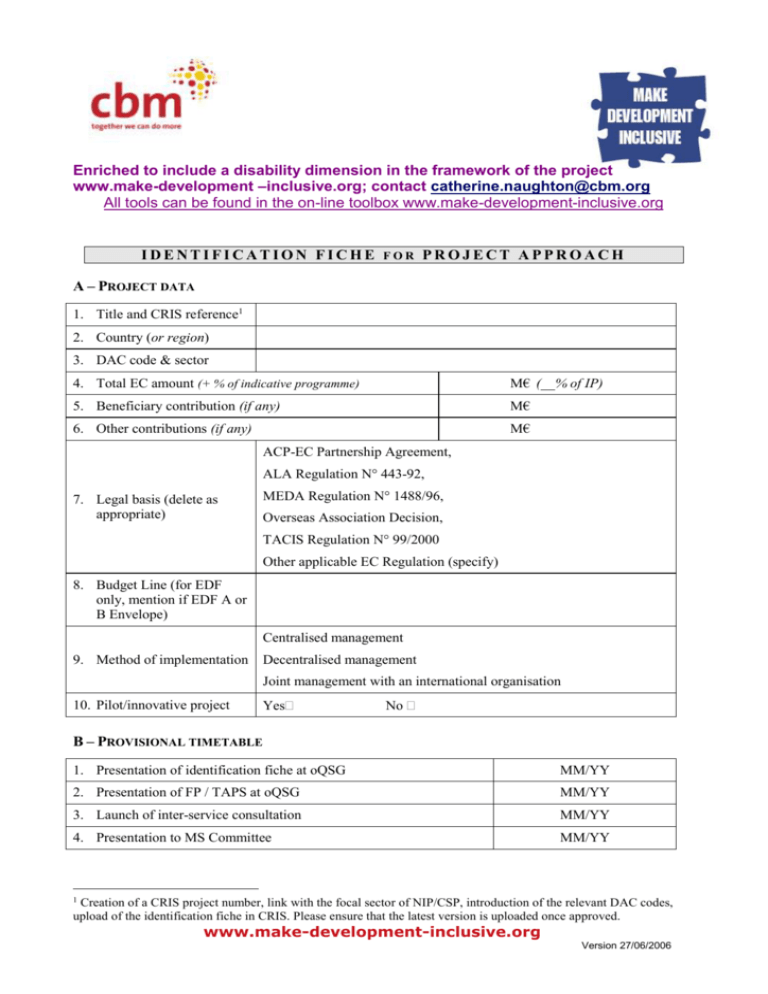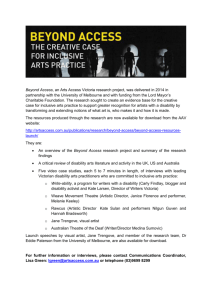revised identification fiche
advertisement

Enriched to include a disability dimension in the framework of the project www.make-development –inclusive.org; contact catherine.naughton@cbm.org All tools can be found in the on-line toolbox www.make-development-inclusive.org IDENTIFICATION FICHE FOR PROJECT APPROACH A – PROJECT DATA 1. Title and CRIS reference1 2. Country (or region) 3. DAC code & sector 4. Total EC amount (+ % of indicative programme) M€ (__% of IP) 5. Beneficiary contribution (if any) M€ 6. Other contributions (if any) M€ ACP-EC Partnership Agreement, ALA Regulation N° 443-92, 7. Legal basis (delete as appropriate) MEDA Regulation N° 1488/96, Overseas Association Decision, TACIS Regulation N° 99/2000 Other applicable EC Regulation (specify) 8. Budget Line (for EDF only, mention if EDF A or B Envelope) Centralised management 9. Method of implementation Decentralised management Joint management with an international organisation 10. Pilot/innovative project Yes No B – PROVISIONAL TIMETABLE 1. Presentation of identification fiche at oQSG MM/YY 2. Presentation of FP / TAPS at oQSG MM/YY 3. Launch of inter-service consultation MM/YY 4. Presentation to MS Committee MM/YY 1 Creation of a CRIS project number, link with the focal sector of NIP/CSP, introduction of the relevant DAC codes, upload of the identification fiche in CRIS. Please ensure that the latest version is uploaded once approved. www.make-development-inclusive.org Version 27/06/2006 Date: Signed: (Head of Delegation or Head of Unit) Task manager: Geographical co-ordinator: www.make-development-inclusive.org Version 27/06/2006 C – FINDINGS AT THE END OF THE IDENTIFICATION STAGE (length: max 8 pages) 1. Summary description Provide a short and clear description of the objectives, purpose and expected results of the proposed project and of the identification phase process (meetings held, missions carried out) and list in an annex all relevant documents that have been used. Summarize to what extent the proposed project is in line with the Paris Declaration and EU commitments on the aid effectiveness agenda2. 2. Consistency with EC policy, programming framework and aid effectiveness agenda Demonstrate that the project proposal is consistent with, and supportive of, the EC development and cooperation policies and programmes (as detailed in development policies, cooperation agreements and CSP/NIP, Action Plans, Mid-term Reviews etc.) Illustrate how it relates to the EC cross-cutting issues (good governance and human rights, gender equality and environmental sustainability). Justify the use of ‘project approach’ (rather than SPSP and/or GBS). Explain how the project proposal integrates main principles of the Paris Declaration and EU commitments. Disability checkpoint: Are there disability-relevant projects or activities in the plan/programme? See “Is disability inclusion relevant to your field of work” Has disability been included in CSP? Is any disability inclusion can be in line with the CSP? See “How to explore options for inclusion of a disability perspective in a CSP” 2 Refer in particular to: a) the Partnership Commitments and Indicators in the Paris Declaration on Aid Effectiveness http://www.oecd.org/topic/0,2686,en_2649_3236398_1_1_1_1_37413,00.html); b) and to additional Indicators on Aid Effectiveness agreed by the EC : 1) Provide all capacity building assistance through coordinated programmes with a preference towards multi-donor agreements; 2) Channel 50% of governmentto-government assistance through the recipient country’s national budget; 3) Avoid establishment of new project implementation units; 4) Reduce the number of uncoordinated missions by 50%. www.make-development-inclusive.org Version 27/06/2006 3. Consistency with Partner Government(s) policies and strategies Describe briefly the Partner Government’s development or reform policy and strategy, including Poverty Reduction Strategy and sector policy. Key issues to be described are the soundness of the strategy; the national ownership of and commitment to the strategy, national resource commitments and key initiatives undertaken. Demonstrate the project proposal’s consistency with these national policies and strategies. 4. Problem analysis Identify the main problems that the project would help to address, providing a brief analysis of the cause and effect relationship (based on the PCM Problem Tree technique). Appropriate linkage should be made to the stakeholder analysis in terms of identifying who is most affected by the problems (including equity issues) and the nature of any identified institutional and organisational weaknesses. Disability checkpoint: Has the proposed project(s) involved a study of the degree to which it is disability-relevant? See “Different degrees of inclusion ” See ‘Planning for all’ Justifications for including disability in various sectors 5. Stakeholders analysis Briefly identify key stakeholders and target groups (gender and vulnerable groups disparities should be specifically considered), describe their primary interests/roles and highlight key issues emerging from the analysis of the institutional framework and of the organisational capacity. Assess the likely capacity of project partners to participate in and implement the project. Evidence should be provided of local commitment to/ownership of project ideas. Disability checkpoint: Have the relevant stakeholders implicated in issues of disability inclusion been identified? Have they been involved? See “Who are the Stakeholders for disability inclusion” See “Specific support to the stakeholders for disability inclusion” www.make-development-inclusive.org Version 27/06/2006 See Different degrees of inclusion 6. Strategy analysis, lessons learned and link with complementary actions Summarise the analysis of options for the EC response, based on the findings described in the above sections, and provide a brief justification for the choice of focus. Reference should be made to lessons learned from previous or ongoing projects and programmes, and these lessons should be reflected in the proposal. Describe the complementarity with other actions of both the EC and other donors and stakeholders. Present the status of donor coordination. Explain if the proposed project is being developed in coordination with other donors. Disability checkpoint: Does the strategy chosen present any potential physical or social barrier to people with functional limitations? See “Planning for all” See ‘Identification & Formulation: How to include a disability perspective’ 7. Proposed project description Describe the proposed hierarchy of project objectives and expected results (using the structure of the Logical Framework). Ensure coherence with relevant policy or sector objectives and cross-cutting issues3, and demonstrate logical links between the identified problems and the objectives proposed. These should build on the description of the strategy options considered. Identify indicative main activities to be implemented. Disability checkpoint: Is the project (activities and outputs) accessible to people with functional limitations? 3 Guidance to operationalise the policy principles of mainstreaming good governance and human rights in all EC development aid can be found in the Draft Handbook on Promoting Good Governance in EC Development Cooperation (http://europa.eu.int/comm/europeaid/projects/eidhr/themes-governance_en.htm ). Practical guidance on how to mainstream gender equality can be found in the Toolkit on Mainstreaming Gender Equality in EC Development Cooperation, Section 1, ch. 4.2 and related tool 6.9: Gender equality screening checklist to be used at project identification stage (GESCI) (http://europa.eu.int/comm/europeaid/projects/gender/toolkit_en.htm ). Practical guidance to mainstream environmental issues can be found in the “Environmental Integration Handbook for Development Co-operation" available on line at the following address: http://ec.europa.eu/europeaid/reports/index_en.htm). www.make-development-inclusive.org Version 27/06/2006 Can persons with disabilities equally participate in the activities? Can they equally benefit from the outputs? If activities reveal to have a substantial disabling effect, or creating barriers; what are the proposed arrangements made to reduce this negative effect or the barriers? See “Planning for all” 8. Resource and cost implications (includes proposal for scope of ECOFIN analysis) Provide a brief description of the likely type and scope of resources required to implement the proposed project (i.e. services, supplies, works and operating costs). Preliminary cost estimates should be provided, including the likely contributions from different stakeholders (EC, beneficiary countries or other donors) and the ability of local partners to meet any additional recurrent costs upon completion of the project investment. The results of any preliminary economic and financial analysis should be presented, as well as the scope of any required subsequent analysis to be carried out during the formulation stage. Disability checkpoint: What are the extra costs that enable the inclusion of persons with disabilities in the project? See “Budgeting the inclusion of a disability perspective” 9. Implementation issues Describe and justify the proposed methods of implementation (in particular, the choice between centralised, decentralised and joint management). Define the anticipated project management, coordination and financing responsibilities and arrangements, giving focus to how these will build on existing structures4 and support capacity building objectives, to strengthen local involvement and ownership. Consider the potential for "harmonising support for capacity development"5. 4 Refer to Partnership Commitment n. 21 and Indicator n. 6 of the Paris Declaration. See as well EU commitment n. 3 ("Avoid establishment of new project implementation units"). 5 Refer to Partnership Commitment n. 22 to 24 and Indicator n. 4 of the Paris Declaration.. See as as well EU commitment n. 1 ("Provide all capacity building assistance through coordinated programmes with a preference towards multi-donor agreements"). www.make-development-inclusive.org Version 27/06/2006 Give a preliminary description on how the monitoring of the project is envisaged and how/when/by whom performance indicators will be developed, including indicators regarding the achievement of cross-cutting issues. Consider the potential for harmonizing project monitoring with other donors so as to align with reporting/monitoring frameworks being developed by partner countries6. Disability checkpoint: Is the degree of participation of persons with disabilities adequate with the relevant degree of inclusion? See “Different degrees of inclusion” 10. Assumptions and risks Identify and assess the assumptions and risks directly or indirectly affecting the project. Disability checkpoint: While defining the risks and assumptions: Do you assume that there is no person with disabilities in the project area? Do you assume that persons with disabilities are not concerned by the sector of intervention? See “Is disability relevant to your field of work” 11. Sustainability Based on the above, assess the likelihood of a sustainable continuation of benefits produced by the project after the period of EC support has ended. Key factors that impact on the likelihood of sustainability include: a) ownership, b) appropriate technology, c) institutional and management structures, d) economic and financial viability, e) adoption of good governance principles7, f) environment, g) socio-cultural issues and h) gender equality. Disability checkpoint: Will the activity result in sustainable improvements from the standpoint of persons with disabilities? 12. Next steps, work-plan and time schedule for the formulation phase Provide a work plan and time schedule of activities, indicating the expected responsibilities, duration/timing and resource requirements for the next steps in formulation. Indicate where 6 Refer to Partnership Commitment n. 44 and 45 and Indicator n. 11 of the Paris Declaration Participation and ownership, equity, organisation adequacy, transparency and accountability, conflict prevention and anti-corruption. 7 www.make-development-inclusive.org Version 27/06/2006 decisions need to be taken, or where further work needs to be carried out including areas where advice and guidance is sought from headquarters (in particular from the Directorate “Operations Quality Support”, AIDCO E). For example: (i) further work to ensure that cross-cutting issues of governance, gender, and environment are incorporated into the proposed project (Environmental Impact Assessment, Gender Analysis, Good Governance assessment etc., as appropriate) Disability checkpoint: Do further work to ensure that disability is incorporated into the proposed project? See “preparing terms of references – identification phase” (ii) further work to analyse the economic and financial impact, as appropriate. (iii) further work to refine the objectives, budget and implementation modalities. (iv) further work to ensure that lessons learnt from relevant similar programmes are incorporated in the project design. (v) further work to ensure proper donor coordination in line with the commitment to "reduce the number of separate, duplicative, missions to the field and the diagnostic reviews"8. (vi) further work to ensure completion of feasibility studies and relevant tender documents. Provide a work plan and time schedule of activities, indicating the expected responsibilities, duration/timing, resource requirements and implementation modalities for the next steps in formulation. Identify particular areas of risk that could affect the preparation of the project as specified in the work plan and time schedule. Where appropriate9, draft terms of reference, tender documents etc. for the next steps in the formulation of the project should be attached. 8 See Partnership Commitment n. 32 and Indicator n. 10 of the Paris Declaration; see as well EU commitment n. 4 ("Reduce the number of uncoordinated missions by 50%"). 9 For example draft terms of reference for the formulation phase and tender documents for infrastructure projects. www.make-development-inclusive.org Version 27/06/2006








